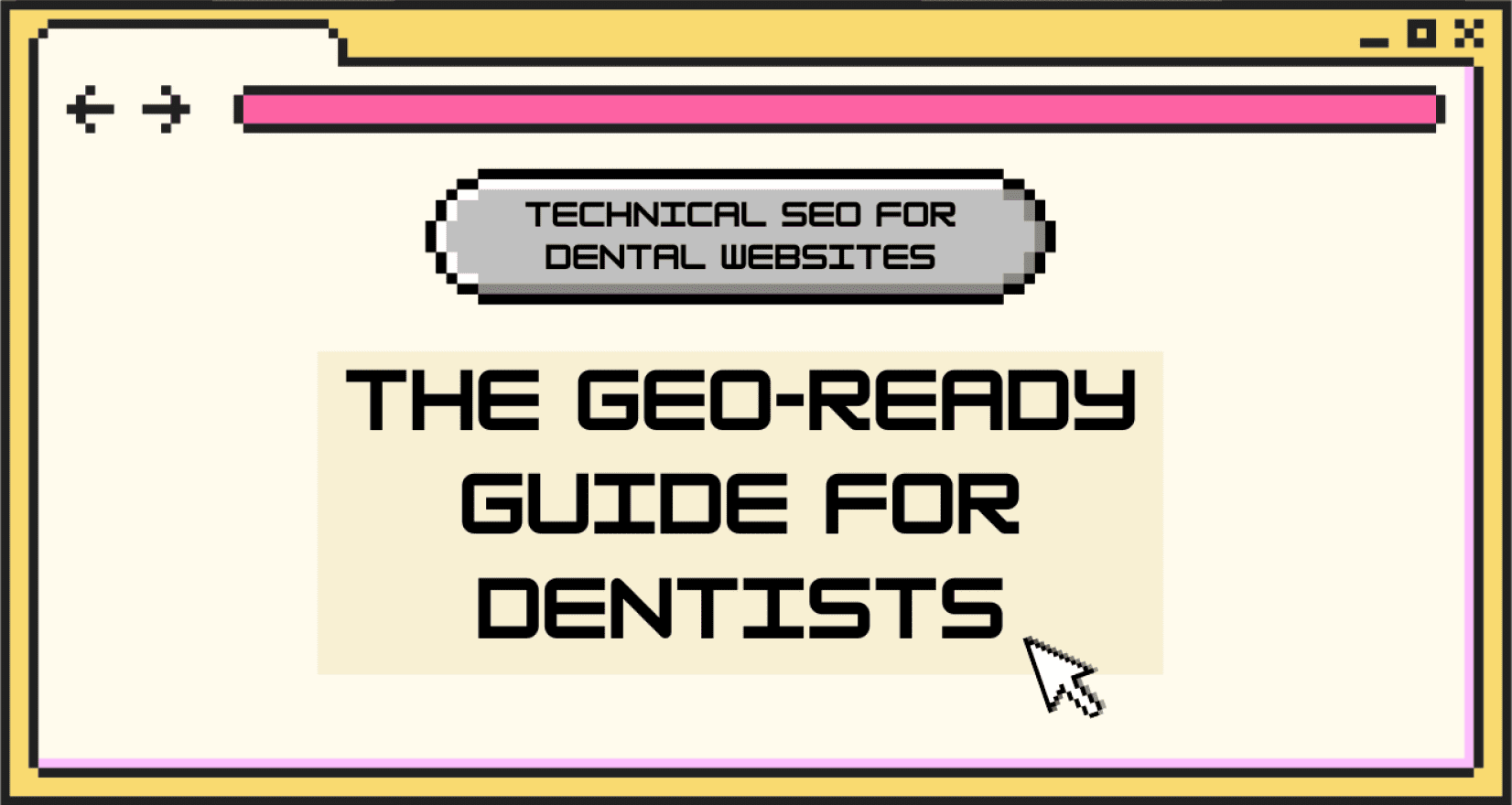
Technical SEO for Dental Websites: The GEO-Ready Guide for Dentists (That Won’t Make Your Eyes Glaze Over)
If you’ve ever looked at your Google rankings and thought, “We used to be higher than that…” you’re not alone.
Even the best-looking dental websites can quietly lose traction when the technical side of SEO falls behind. Search algorithms, AI-powered search tools, and local ranking factors change constantly, and your site’s backend has to keep up if you want to stay visible.
That’s where technical SEO for dental websites comes in. It’s the behind-the-scenes foundation that helps both Google and AI systems (like Google’s AI Overviews and ChatGPT-style search assistants) find, understand, and trust your website content. In short, it’s how you make sure your content actually gets seen instead of floating around in the metaphorical void of online dental content.
All this is well and good, but recently, there’s been a teeny, tiny, little update in the world of technology that you may have heard of: artificial intelligence. GEO, or Generative Engine Optimization, is a new consideration that dentists have to be mindful of in all of their dental marketing. Not only does Google have to see your stuff, but AI search engines (aka our future robot overlords) need to find it, too.
Fortunately, most of what helps your site show up in search also helps it appear in AI-generated responses, and you don’t need to be an elite hacker from an 80’s movie to understand it. You just need to know what matters, and what to stop worrying about. (Or you need to hire a team of super talented and attractive dental marketing experts to handle your website and technical SEO for you.)
In this guide, we’ll break down the invisible but important side of dental SEO services, from crawlability and speed to structured data and local performance. You’ll learn how small technical improvements (plus the right dental web design) can lead to big gains in visibility, clicks, and new-patient calls without a single keyword-stuffed sentence in sight.
Think of it like dental hygiene for your website! A little consistent maintenance keeps everything clean, functional, and free of gum bleeding when the dental hygienist tries to floss your teeth.
Table of Contents
- What Even Is Technical SEO?
- GEO 101: Make Your Content Easy for AI to Quote
- Site Speed That Patients (and Google) Love
- Content Structure: Make Pages Easy to Skim for People and Machines
- Structured Data for Dentists: The “Speak-AI” Toolkit
- Technical Infrastructure: Make Your Dental Website Easy to Trust
- Local Technical SEO: Fuel Your Google Maps & “Near Me” Visibility
- Quick Wins: A 60-Minute Technical Tune-Up
- Advanced Projects That Are Worth It in the Long Run
- The Invisible Work That Makes Your Dental Website Win
- FAQ
What Even Is Technical SEO?
“Technical SEO” sounds like something you’d need a programming degree (and maybe a pot of coffee) to understand. But in plain English, it just means making your dental website easy for Google to find, understand, and trust.
If Google can’t crawl your pages, it can’t index them. If it can’t index them, you won’t rank. And if you don’t rank… well, let’s just say that new patients aren’t wandering all the way to the desolate wasteland that is page two.
Technical SEO is the digital equivalent of good clinical systems. You know, the things your patients never see but that keeps everything running smoothly behind the scenes, like a good PMS or weekly donuts in the break room. Crucial stuff. When your site loads quickly, follows modern coding standards, and is structured logically, both humans and machines have a better experience.
Here’s what that means in practice for dental websites:
- Crawlability & indexability: Search engines can easily find and understand your pages.
- Site speed: Your site loads quickly on mobile and desktop (because nobody wants to wait for that smiling team photo to finish loading, no matter how shiny and bright your cute little faces are).
- Structured data (schema): You’re literally telling Google what’s on the page: “Hey, this is our cosmetic dentistry service, neato!”
- Security: HTTPS protects user data, which is especially important when you’re collecting patient inquiries.
- Mobile-friendliness: Your website should look and function great on any device, especially smartphones, because nobody takes their laptop to scroll through while sitting on the potty.
These are the building blocks of strong dental SEO services. They work quietly in the background but directly influence how high your pages rank, how quickly they load, and whether or not Google (or AI-powered search) trusts your site enough to include it in results.
And speaking of AI, let’s channel our inner 6-year-olds and dig into GEO (Generative Engine Optimization) like we’re hyper-fixated becoming paleontologists when we grow up.
GEO 101: Make Your Content Easy for AI to Quote
You’ve probably heard the buzz about “AI search” or seen Google’s new AI Overviews showing up at the top of results, unless you are dead. RIP, and thank you so much for visiting our dental blog even on the spiritual plane, I commend you for committing to the hustle of running a dental office even now that you’ve shed your mortal coil.
Anyway, AI. It’s a little strange, right? You type in a question about teeth whitening, and an AI-generated summary pops up, sometimes even quoting websites directly.
The question for dentists is: how do we make sure your practice is the one being quoted?
That’s where GEO, or Generative Engine Optimization, comes in. GEO is the 2025 upgrade to SEO. It’s all about structuring your website so AI systems can easily understand, extract, and cite your content, but the two concepts support one another. Instead of just ranking on page one, the goal is to be included in the actual AI-generated answer.
Here’s an explanation of how it works (without the tech headache):
- AI systems love clarity. They prefer clean layouts, short paragraphs, bullet points, and structured information. (Basically, everything that also helps humans skim.)
- Schema markup matters more than ever. When you label your pages correctly (for example, telling Google “this is a Service page about Invisalign”) AI knows exactly what your content is about.
- Trust and accuracy win. Clear authorship, up-to-date info, and consistent local details make your content more “trustworthy” to both Google and AI platforms.
If you want your site to appear in an AI Overview or a “People Also Ask” snippet, your goal is to make your content as easy as possible for machines to understand and reuse.
So, when you clearly explain something like:
“How long does a dental crown last?” or “What’s the difference between veneers and bonding?” you’re helping patients, making your website valuable for local SEO results, and feeding AI assistants the exact information they need to quote you (with your practice name attached).
Quick GEO checklist for dental websites:
- Add FAQ sections to service pages (insurance, pricing, procedure steps).
- Use schema for services, reviews, and location details.
- Keep your content updated. AIs favor freshness.
- Optimize for speed and structure (slow sites often get skipped).
Site Speed That Patients (and Google) Love
Let’s talk about the first impression your dental website makes. You’ve got about three seconds before most people decide whether they’re staying or bouncing, and that isn’t enough time to peruse your beautiful smile gallery page or read your thoughtful, controversial, and brave blog post exposing the tooth fairy as nothing more than fiction.
Google knows this, and so do AI systems. That’s why speed and performance are make-or-break factors for your visibility. If two whitening pages say the same thing, Google and AI are going to choose the faster, smoother one every single time.
The Science of Technical SEO for Dental Websites
When SEO nerds (us! We’re the SEO nerds!) talk about Core Web Vitals, here’s what they mean in plain English:
- LCP (Largest Contentful Paint) – how fast the main content loads. Aim for under 2.5 seconds.
- CLS (Cumulative Layout Shift) – how much the page jumps around while loading (you know that “tap the wrong button by accident” feeling). Keep it minimal.
- TTFB (Time to First Byte) – how fast your server responds. Under 200ms = Usain Bolt.
These metrics aren’t just for bragging rights. Faster sites rank better, convert more, and frustrate fewer people.
Common “Speed Killers” on Dental Websites
- Massive, high-resolution team photos that load slower than your brain at 4:30 on a Thursday.
- Photo galleries that try to load 40 “before and after” images all at once.
- Autoplay video headers, chat popups, and review widgets fighting for attention.
- A mountain of WordPress plugins, some of which you don’t even use anymore, none of which you remember downloading.
Quick Fixes You’ll Actually Do
Here are a few easy wins you (or your amazing and sexy dental web team) can knock out this month:
- Compress and resize images. Use modern formats like WebP or AVIF, and enable lazy loading so galleries load only when needed.
- Clean up your code. Remove duplicate plugins and scripts that slow your site down.
- Use caching and a CDN. A Content Delivery Network stores your content on servers around the world so pages load fast everywhere.
- Defer non-essential scripts. Let chat tools, popups, and fancy sliders load after the important stuff.
- Test regularly. Use Google PageSpeed Insights or GTmetrix once a quarter to keep an eye on your vitals.
Speed also impacts conversion. A one-second delay can reduce leads by up to 7%. Ouchie. When your pages load fast, patients are more likely to schedule, call, or find directions without frustration.
Content Structure: Make Pages Easy to Skim for People and Machines
Most people (and search engines) don’t read websites, they scan them.
If your content is one long block of text, both your patients and Google are going to skip it because as a society our attention spans have been conditioned by the TikTok algorithm to match that of the average goldfish. Google knows this, and it takes that into account. Let’s ignore the dire implications of this for our survival as a species and move on.
This trend is why content structure is a big part of technical SEO. A well-organized website helps humans find what they’re looking for and makes it easy for search engines — and now AI systems — to understand what your pages are about.
It’s Like a Neat Little Filing Cabinet
Your website should have a clean, logical structure, not a junk drawer full of random pages and free keychains from the local carwash. That means:
- Clear URLs:
- /services/teeth-whitening/
- /services/dental-implants/
- /locations/salt-lake-city/
- Logical headings: Each page gets one H1 (the title), then subheadings (H2, H3) that break up topics.
- Short paragraphs & bullets: Easy to skim on mobile, and easier for AI to extract.
- Internal links: Connect related content with live links so visitors and crawlers don’t hit a dead end.
Pages That Work for Both Search Engines and Patients
Here’s what structure looks like in real life on a dental website:
- A main Services page acts as a “pillar,” linking to all your procedures.
- Each service page (like dental implants or Invisalign) links back to that pillar and to related FAQs or blog posts.
- Location pages include directions, parking info, and a link to your Google Map, all using consistent NAP info (Name, Address, Phone).
- Add breadcrumbs (“Home > Services > Dental Implants”) to help users navigate and give Google a clear map of your site hierarchy.
Formatting That AI and Patients Both Love
- FAQs — Perfect for quick answers about insurance, pain levels, or recovery time.
- Numbered steps — Ideal for “What to expect during your first visit.”
- Comparison tables — Veneers vs. bonding, in-network vs. out-of-network.
- Visuals with captions — Helps AI understand your multimedia content (and helps patients know what they’re looking at).
When your content is neatly structured, it sends a strong signal to Google that your site is organized, authoritative, and easy to crawl. And when it’s easy for people to read, you’ll keep them on the page longer, which is another ranking win.
Structured Data for Dentists: The “Speak-AI” Toolkit
If content structure helps people and search engines read your site, then structured data helps them understand it. Think of it like labeling your instruments in the sterilization drawer. Everything’s still there whether it’s organized or not, but now it’s clearly marked and ready for quick use.
In SEO-speak, this labeling system is called schema markup, and it’s one of the biggest behind-the-scenes tools in both traditional search and GEO (Generative Engine Optimization). It tells Google and AI systems exactly what’s on your website — your services, reviews, location, team info, and more — so they can confidently surface your content in search results and AI summaries.
Why It Matters for Dental Websites
Search engines, much like Santa Claus checking the weather forecast pre-Rudolph, love clarity. When you add schema markup, you’re giving them a cheat sheet that explains who you are and what you do. This helps you:
- Show up with rich results (like star ratings, FAQs, or appointment info).
- Improve your chances of being quoted in AI answers.
- Build trust signals that make your site look more credible.
The Must-Have Schema for Dental Practices
You don’t need to mark up everything, just the most important stuff:
- LocalBusiness (Dentist subtype): Includes your practice name, address, hours, phone, logo, and links to social profiles.
- FAQPage: For those “Does insurance cover this?” and “What should I do in a dental emergency?” sections.
- Service: For procedures like teeth whitening, implants, or Invisalign. Describe each service clearly and (if applicable) note pricing or special offers.
- Organization + Author: Builds credibility when your blog or page lists a specific dentist as the content source.
- Review / AggregateRating: If you display reviews (and they’re legitimately earned), structured data can help Google show them in search results.
- BreadcrumbList: Helps both users and crawlers understand your site hierarchy.
- VideoObject or ImageObject: If you have educational videos or procedure explainers, this helps them appear in Google’s image or video results.
How to Keep Schema Clean and Compliant
- Use JSON-LD (that’s Google’s preferred format and the easiest for your amazing, incredible, beautiful dental web team).
- Keep your markup accurate and synced with what’s actually visible on the page.
- Test your schema in Google’s Rich Results Test before publishing.
- Don’t go markup-crazy. Adding unnecessary schema can confuse Google instead of helping.
Adding proper schema is one of those low-effort, high-reward moves that pays off twice with better visibility today and stronger positioning as AI-powered search continues to evolve.
Technical Infrastructure: Make Your Dental Website Easy to Trust
Even the best-looking dental website with the most beautiful 2008 glitter MySpace gifs won’t show up anywhere if Google and AI systems can’t access it, crawl it, or trust it.
Technical infrastructure is all the invisible stuff that tells search engines, “Yep, this website is safe, fast, and reliable.” It’s like building infrastructure. Without well-maintained plumbing, you’d quickly be swimming in…
Well. You get it.

1. Crawlability & Indexability
If Google can’t find a page, it can’t rank it. If AI can’t access a page, it won’t quote it.
So make sure your site is open for discovery:
- Don’t block important pages in your robots.txt file.
- Submit an XML sitemap (with <lastmod> tags) through Google Search Console so crawlers know what to prioritize.
- Use noindex only for pages that don’t need to show up in search, like thank-you pages, admin areas, or staging/test URLs.
- If you’ve changed URLs over time, set up 301 redirects to preserve link equity (and avoid dead ends).
2. Rendering and Accessibility
Modern dental websites use JavaScript for design features, animations, or booking tools, but if critical text or navigation hides behind code that Google can’t read, that’s a problem.
- Make sure essential content (like your services, location, and contact info) loads without JavaScript.
- Use server-side rendering for any core content or menus.
- Always preview your pages in Google’s URL Inspection Tool to see what the crawler actually sees.


3. Security (Seriously, Don’t Skip This, It’s So Important, Please, We Beg You)
Google favors secure sites, and patients expect it. Because duh.
- Use HTTPS across your entire site. (Browsers now label HTTP as “Not Secure.”)
- Keep your SSL certificate valid and up to date.
- Secure your forms, especially if they collect personal or health-related details.
- Bonus: Add basic security headers (like Content-Security-Policy and X-Frame-Options) for an extra trust signal.
4. Freshness Signals
AI systems (and Google) both love recent, reliable content.
- Include visible “last updated” dates on key service pages.
- Update your sitemap regularly.
- When you add new services, blog posts, or location info, make sure Google can see the changes.


5. Staging & Development Hygiene
If you’re working on a redesign or staging version of your site:
- Password-protect the staging environment so Google doesn’t accidentally index it.
- Double-check that old URLs redirect properly when you launch the new version.
Local Technical SEO: Fuel Your Google Maps & “Near Me” Visibility
If technical SEO is the foundation, local SEO is the street sign that tells nearby patients, “Hey, this is the dentist you’re looking for.”
When someone searches “dentist near me,” “Invisalign in [city],” or “emergency dentist open now,” Google’s not just checking who has the best keywords, it’s pulling signals from your website’s technical setup, your Google Business Profile (GBP), and your local citations to decide who deserves the spotlight. You’re brawling with the dentist down the street, and your weapons are your fists, your moxy, and your consistent NAP across multiple citations. (For legal reasons, this is a joke. Please do not punch your competitors or bully them with your superior local SEO acumen because that’s not nice.)
So if you want to dominate those local dental SEO results and get more map clicks and calls, here’s how to fine-tune your technical setup.
1. Create Unique Location Pages
If you have more than one office, don’t send everyone to the same “Contact Us” page.
Each location deserves its own optimized page that includes:
- Full NAP (Name, Address, Phone) exactly as it appears on your Google Business Profile.
- Hours, directions, and parking info (bonus points for nearby landmarks).
- Dentist bios or team intros specific to that office.
- Services actually offered at that location (not just copy-pasted from another city).
- Embedded Google Map using your actual GBP listing.
- Compressed, geo-tagged photos of your office exterior, lobby, and staff (AI and humans both love seeing the real deal).
Pro tip: Name image files descriptively — “dental-office-salt-lake-city.webp” does way more for SEO than “IMG_4539.jpg.”
2. Keep Your Google Business Profile (GBP) Technically Healthy
A strong GBP listing is basically your online storefront.
Here’s how to make it technically bulletproof:
- Use consistent categories (e.g., “Dentist,” “Cosmetic Dentist,” “Emergency Dental Service”).
- Make sure your appointment link points to a fast, mobile-friendly page, not a generic homepage.
- Keep hours, address, and phone number identical across your site and all directories.
- Add UTM tracking to your GBP links so you can measure traffic in Google Analytics.
- Update your GBP photos regularly (Google loves fresh content).
3. NAP Consistency & Local Citations
Google hates mixed signals. If your name, address, or phone number is inconsistent across directories, it lowers trust.
- Audit major listings (Google, Yelp, Healthgrades, Facebook, Apple Maps, Bing Places, etc.) at least twice a year.
- Fix duplicates or outdated info.
- Use a citation management tool (or let My Social Practice handle it. We’ve got systems for that).
4. Internal Linking for Local Relevance
Your site structure should reinforce your local authority.
- Link from your homepage → city pages → related service pages (e.g., “Dental Implants in Lehi, UT”).
- Include internal links between nearby offices if you have multiple locations (“Also serving Orem and Provo patients”).
- Use descriptive anchor text like “family dentist in [city]” — not just “click here.”
5. GEO & “Near Me” Search Signals
Remember GEO (Generative Engine Optimization)? It’s not just for national results. It matters locally, too.
Structured, location-specific content increases your chances of being cited in AI-powered “near me” answers. That means:
- Use LocalBusiness schema for each office.
- Add geo coordinates and link each location to its city-specific service pages.
- Keep your contact info crawlable (avoid hiding it in images or pop-ups).
Think of local technical SEO as giving Google and AI assistants a GPS signal straight to your front door. The clearer your coordinates, the more likely patients are to find you first.
Quick Wins: A 60-Minute Technical Tune-Up
Not every SEO improvement has to be a massive project. In fact, a few quick fixes can have a big impact, especially if it’s been a while since your last website checkup.
Here’s a one-hour power session checklist that can make your dental website faster, cleaner, and more visible (without breaking anything).
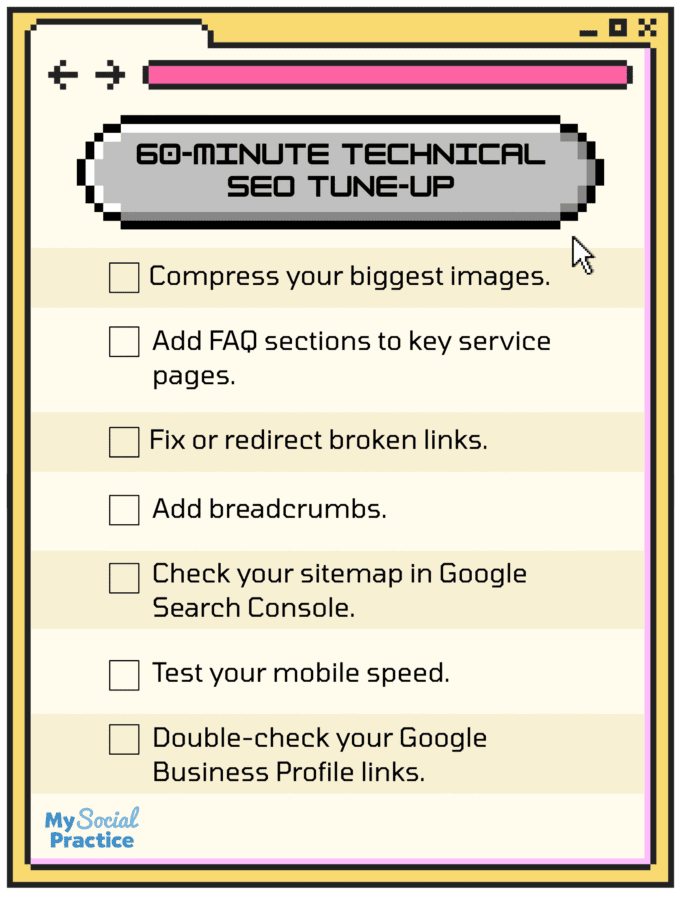
1. Compress your biggest images.
Run your homepage and top service pages through TinyPNG or Squoosh. Aim to cut file sizes in half without losing quality.
2. Add FAQ sections to key service pages.
Start with your top three: teeth whitening, dental implants, and Invisalign. These are perfect spots to add short, helpful Q&A — and they’re easy to mark up with FAQ schema.
3. Fix or redirect broken links.
Use a free broken link checker or plugin to catch any 404 errors. Redirect old or deleted pages to the closest match (like your current version of that service).
4. Add breadcrumbs.
They help both visitors and search engines understand your page structure:
Home → Services → Dental Implants
5. Check your sitemap in Google Search Console.
Make sure it’s up-to-date and that Google isn’t skipping any important pages.
6. Test your mobile speed.
Visit your homepage on your phone using PageSpeed Insights. If your score’s below 70, it’s time to optimize images and plugins.
7. Double-check your Google Business Profile links.
Your “Appointment” and “Website” buttons should go directly to fast, crawlable pages, not just the homepage.
You don’t have to be a developer to do any of these, and if you’re already a My Social Practice client, our magnetic, charismatic, alluring dental website team handle most of them for you automatically.
Advanced Projects That Are Worth It in the Long Run
Once you’ve knocked out the quick wins and your site’s running smoothly, you can move on to the fun stuff! You know, the deeper optimizations that make Google (and AI) take you seriously. That’s your definition of fun too, right?
These projects take a little more time or technical know-how, but they can make a big difference in how visible, fast, and future-proof your website is.
These projects might take a little more elbow grease, but they’re the difference between a “good” website and one that’s built to win now and in the future.
1. Fine-Tune Your Core Web Vitals
If your dental website were a car, this would be the engine tune-up.
- Optimize images and fonts for faster rendering.
- Use critical CSS to prioritize the visible parts of the page first.
- Keep layout shift (that annoying page jump) under control.
This helps your site load lightning-fast, which improves rankings and keeps visitors from rage-tapping the back button and offending the holy spirit with very naughty swear words.
2. Add Hreflang for Multilingual Sites
No, “Hreflang” is not a dwarven city in a Tolkien novel.
If your practice serves bilingual communities (English/Spanish, for example), adding hreflang tags tells Google which version of each page to show users based on their language or region.
It’s a technical setup, but it’s a huge win for clarity and for appearing in the right local results.
3. Analyze Your Crawl Logs
This is where you get geeky. Throw on a black hoodie and get ready to say, “I’m in” to whoever is nearby. By checking your server logs, you can see how often Googlebot and AI crawlers visit your site and which pages they skip. It helps you spot crawl waste and identify important pages that aren’t being seen often enough.
4. Redirect Mapping: Reclaim Lost Links
Over the years, dental websites go through redesigns and URL changes. Each time that happens, some old links out on the web stop working and that means lost authority.
Do a quick audit to find broken or redirected URLs, then map them to your current live pages. You’ll reclaim link equity you didn’t even realize you’d lost.
5. Consolidate Thin or Duplicate Content
If you’ve got multiple pages covering the same topic (“teeth whitening” vs. “whitening treatments” vs. “zoom whitening”), merge them into one strong, well-optimized page.
Google prefers quality over quantity and a single, comprehensive page can outperform three weaker ones.
You don’t have to handle these projects on your own (and honestly, you shouldn’t have to when you have a bunch of beautiful nerds here to help). Our dental SEO services include all of this plus ongoing monitoring so you’re never left wondering why traffic dipped or what Google’s latest update means for your site.
The Invisible Work That Makes Your Dental Website Win
When it comes to online visibility for dentists, technical SEO is the quiet hero. Patients might never see it, but it’s the reason your website loads fast, ranks high, and shows up in the right local searches.
Every image you compress, every schema tag you add, every redirect you fix all build a stronger, more trustworthy foundation for your digital presence. And now, with GEO becoming part of the search landscape, that solid foundation matters more than ever.
In a happy twist of fate, you’ve found the best dental marketing company in the whole entire world (in my opinion, okay? This is not a factual claim, calm down, horde of lawyers jealously following my every move.) You don’t need to understand every technical detail, you just need a team that does.
At My Social Practice, we make sure your dental website looks amazing and performs flawlessly behind the scenes. From local SEO structure and lightning-fast site speed to schema markup and GEO-readiness, we handle the invisible work that helps patients find and trust you and we do it while looking so badass, seriously, you have no idea.
So if you’re ready for:
- Faster load times (that don’t kill your design)
- More visibility in local and AI-powered search
- A website that turns browsers into booked patients
… Then check out our dental SEO services, explore our dental web design, or request a free technical SEO audit to see where your site stands.
Frequently Asked Questions
How is technical SEO different from dental web design?
Think of web design as how your site looks and feels, and technical SEO as how it runs and performs. Design covers visuals, dental branding, and user experience while technical SEO handles the behind-the-scenes setup that helps Google find, understand, and trust your content. A beautiful website without solid technical SEO is like a gorgeous dental office with a locked front door. Patients can’t get in, Dr. Smith. Unlock the door.
What Core Web Vitals should my dental website aim for?
Core Web Vitals are Google’s way of measuring page experience. Aim for these benchmarks when it comes to technical SEO for dental websites:
- LCP (Largest Contentful Paint): under 2.5 seconds
- CLS (Cumulative Layout Shift): under 0.1
- TTFB (Time to First Byte): under 200ms
Basically: fast, stable, and responsive. If your site loads quickly and doesn’t jump around, you’re good to go.
Which schema markup helps dental SEO services the most?
Start with the basics:
- LocalBusiness (Dentist) — your practice info, address, hours, and contact details.
- Service — specific treatments you offer (like implants or Invisalign).
- FAQPage — for your patient questions and answers.
- BreadcrumbList — helps define your site’s structure.
- Article/BlogPosting — adds author and freshness info to your blog posts.
These schema types make it easier for Google (and AI systems) to quote or display your info in search results.
About the Author: Megan Nielsen is an SEO strategist and the Grand Overlord of copywriting at My Social Practice. My Social Practice is a dental marketing company that offers a full suite of dental marketing services to thousands of dental practices throughout the United States and Canada.
![[Byte Sized Podcast Ep. 23] Frictionless Online Dental Scheduling: Why Your Practice Needs It Now Feat. Colin Ambler - technical SEO for dental websites - My Social Practice - Social Media Marketing for Dental & Dental Specialty Practices online dental scheduling](https://mysocialpractice.com/wp-content/uploads/2025/12/byte-sized_ep23.png)
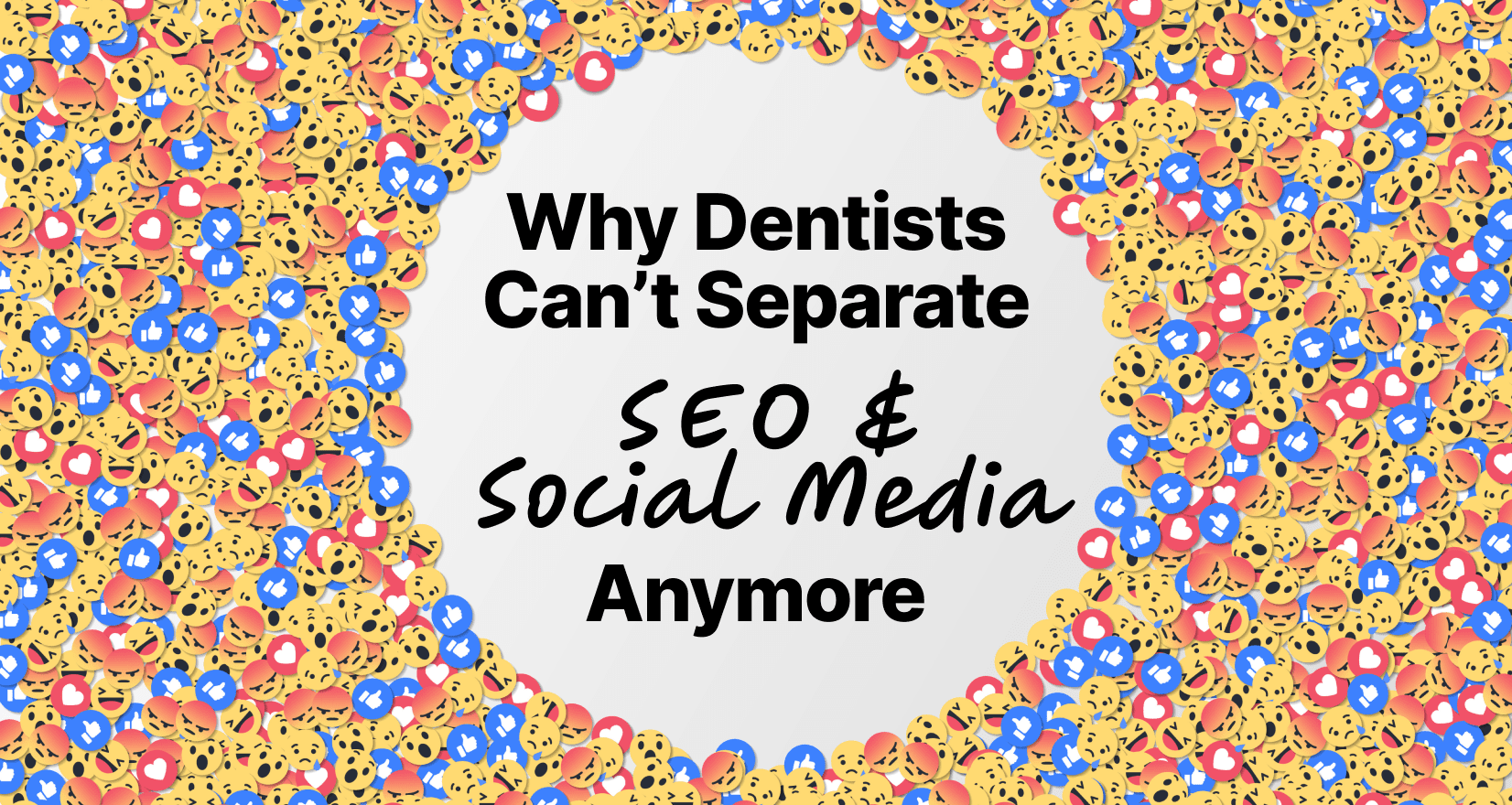



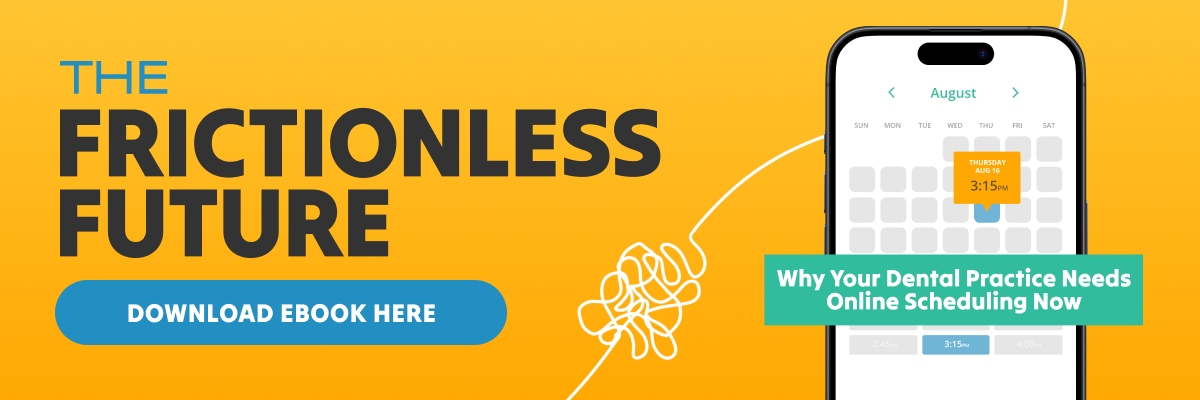




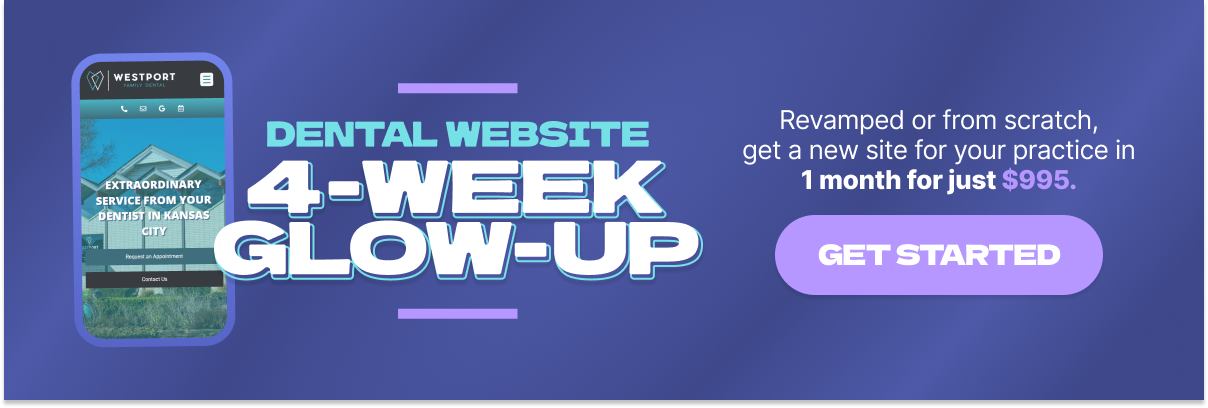

![[Byte Sized Podcast Ep. 23] Frictionless Online Dental Scheduling: Why Your Practice Needs It Now Feat. Colin Ambler - technical SEO for dental websites - My Social Practice - Social Media Marketing for Dental & Dental Specialty Practices online dental scheduling](https://mysocialpractice.com/wp-content/uploads/2025/12/byte-sized_ep23-100x100.png)



